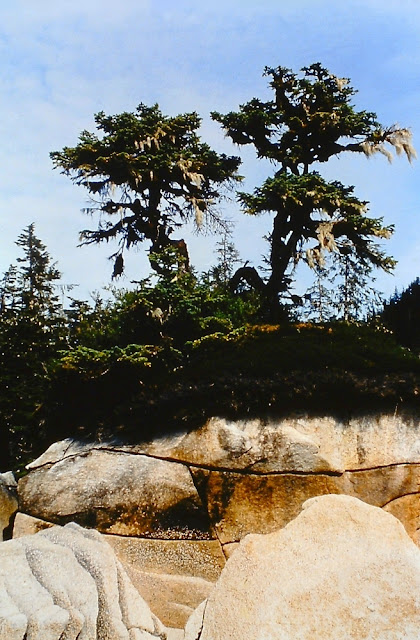Many photos were captured in the days long before digital photography -- oh, for the joys of being able to go back to those times with today's technology! Since that isn't possible, it was my great pleasure to through the "Aialik Bay, 1987" pictures, rescue what I thought were the best, and digitally enhance them to bring the most out of them.
Dave and I were not there on this trip, but I did go out on Ghostrider, and stay aboard several times ... those memories are among my most cherished, and one day I'll get Dave going, have him tell his stories. (He has some astonishing and even hair-raising stories to tell of sailing the Gulf of Alaska in all weathers. I'm sure we can track down some photos to accompany his stories ... the most I can offer is the skill to digitally remaster them!) But for the moment, it's over to Anna for a very beautiful guest post:
Ghostrider in our favorite anchorage in Aialik Bay. First of all, it's not on the charts. It's a tiny little teacup, barely an indentation on the charts. It's protected in all weather events, far enough into the bay that wave action can't impact it. To reach it you either know about it by local knowledge or you follow the shoreline carefully, dodge a couple large ledges of rocks, requiring you to dogleg around the ledges and you're there. The cove is only large enough for two boats, requiring you to run a line to shore to tie the stern of Ghostrider to a very large tree or boulder to hold her in place. You drop your anchor in about 50 feet of water, back down on the anchor to lock it into the sandy bottom, then run a line to shore with a dingy. The surrounding land is granite boulders but millions of years of erosion has created a sand and gravel bottom for an anchor to bite into. Once settled into her anchorage Ghostrider rode out several large storms with barely a motion. We also watched cruise ships sail serenely past, never knowing we were hiding there.
One of the many shorelines leading into Aialik Bay. The Pacific Ocean pounds into the shore, throwing huge spray and creating thunderous booms. It's beautiful and deadly all at once. On a calm day hiking this shoreline reveals rain pools of water in the boulders, warmed by the sun, just needing a towel and some soap for a bath. Sitting in one of those carved rock pools you can watch the ocean for miles, with no sign of human activity.
Have to set the scene. Early morning dawn, around 5 a.m. Sun has been up for hours (it is AK summer after all) but the fog is thick, almost no visibility in our little teacup anchorage in Aialik Bay. Water is still, perfect mirror reflections. Sitting on the cabin roof, coffee in hand, camera at my side. Perfect time for an otter to float by, or a whale.
Through the fog you can hear the calls of eagles and other birds, the occasional slap of wings against the water and even though you can't see them you know that eagles are fishing nearby.
The sun begins to burn through the fog, a white orb appearing in the silver white clouds. The water begins to appear, the fog lifting showing the green reflecting sea.
Sliding out of the fog a bald eagle appears, wings almost touching the water as it glides, looking for a fish just barely under the surface. It reaches for its prey, talons extended and misses. With a single beat of silent wings it rises from the water, disappearing into the fog. In a few moment it appears again, ready for another attempt.
Memories of AK sailing.
Ghostrider carries about 100 gallons of freshwater and on a long voyage it's necessary to supplement it with water from a stream. The trick is to find water that 1), is easy to get to, 2) is not contaminated with either salt or by animals and 3) easy to haul back. Water is heavy, so you have to take that into account in your search. If you find a good source but you can't carry full jugs back to the dingy you've wasted your time. The water retrieved is used for bathing, not cooking or drinking, just in case there is some type of contamination. Fetching enough water for showers for everyone on board can take several hours. And sometimes it's quite the adventure. Launch the dingy, go to shore, find a stream outlet, then take your container for water. Sometimes it's a waterfall, and you can actually row up to the pool the waterfall makes, sink your containers, fill them, and come back. Other times you hike up a stream bed to a small pond. If nothing else it makes you appreciate running water and a tap that you just turn.
Jen, amazing what memories come back. In all the years we roamed Aialik Bay we only shared that anchorage with 3 other boats. Nobody believed it was there until we showed them photos and our chart with all the notes on it on where and how to get there.




















No comments:
Post a Comment